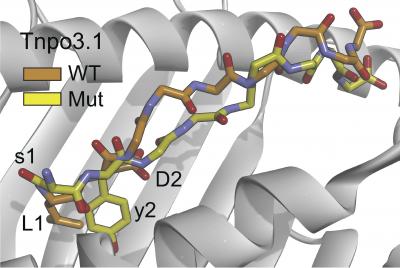New rules for anticancer vaccines

This simulation shows structural differences between mutant (yellow) and normal (orange) immune targets called neoepitopes. Researchers reveal how evaluating these distinctions can help pinpoint neoepitopes that elicit anticancer immune responses. Credit: Duan et al., 2014
As cancer cells divide, they accumulate random mistakes (mutations). This process creates new versions of proteins, some of which are recognized as foreign invaders by immune cells called T cells, prompting the cells to attack and eliminate the cancer cells.
With our current ability to identify all of the mutations in a patient's cancer and to understand which protein sequences can be recognized by T cells, scientists can now predict which mutations will result in new T cell targets (called “neoepitopes”). Some of these neoepitopes can then be used as vaccines to elicit a protective T cell response that destroys the cancer.
But here's the catch. These prediction tools generate hundreds of possible neoepitopes, of which only a handful can actually elicit T cells capable of attacking the tumor. And so far, there has been no reliable common denominator to help pinpoint this useful handful.
Previous attempts to predict cancer neoepitopes have relied on how strongly the mutated protein is recognized by the immune system. But scientists at the University of Connecticut now show that the strength of this interaction is a poor predictor. A better (albeit still imperfect) measure turns out to be how different the mutation looks to the T cell when compared to its normal counterpart—the more distinct, the better. These results have the potential to completely change current approaches to generating anticancer vaccines.
Duan, F., et al. 2014. J. Exp. Med. doi:10.1084/jem.20141308
About The Journal of Experimental Medicine
The Journal of Experimental Medicine (JEM) is published by The Rockefeller University Press. All editorial decisions on manuscripts submitted are made by active scientists in conjunction with our in-house scientific editors. JEM content is posted to PubMed Central, where it is available to the public for free six months after publication. Authors retain copyright of their published works and third parties may reuse the content for non-commercial purposes under a creative commons license. For more information, please visit http://www.jem.org .
Research reported in this press release was supported by Cancer Research Institute NY, Northeastern Utilities, Connecticut Institute for Clinical and Translational Science, SPARK, the National Science Foundation, the National Institutes of Health, Life Technologies, and the USDA National Institute of Food and Agriculture.
Media Contact
All latest news from the category: Health and Medicine
This subject area encompasses research and studies in the field of human medicine.
Among the wide-ranging list of topics covered here are anesthesiology, anatomy, surgery, human genetics, hygiene and environmental medicine, internal medicine, neurology, pharmacology, physiology, urology and dental medicine.
Newest articles

High-energy-density aqueous battery based on halogen multi-electron transfer
Traditional non-aqueous lithium-ion batteries have a high energy density, but their safety is compromised due to the flammable organic electrolytes they utilize. Aqueous batteries use water as the solvent for…

First-ever combined heart pump and pig kidney transplant
…gives new hope to patient with terminal illness. Surgeons at NYU Langone Health performed the first-ever combined mechanical heart pump and gene-edited pig kidney transplant surgery in a 54-year-old woman…

Biophysics: Testing how well biomarkers work
LMU researchers have developed a method to determine how reliably target proteins can be labeled using super-resolution fluorescence microscopy. Modern microscopy techniques make it possible to examine the inner workings…





















